Investigation of Essential or Non-essential Character of Some Hardly Known Trace Elements for Plants
嫌疑与证据英语作文模板
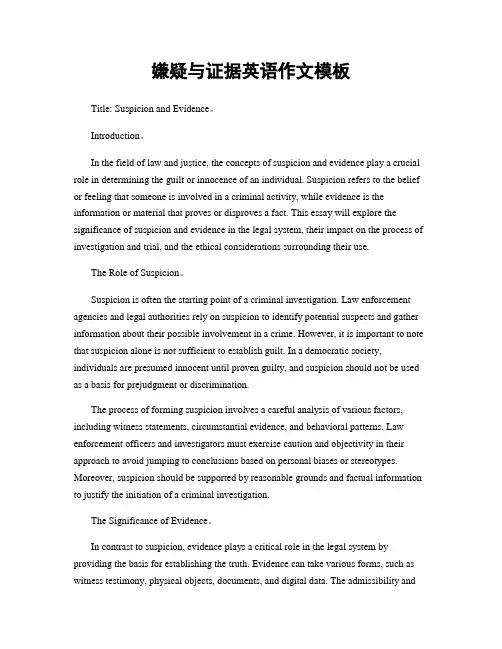
嫌疑与证据英语作文模板Title: Suspicion and Evidence。
Introduction。
In the field of law and justice, the concepts of suspicion and evidence play a crucial role in determining the guilt or innocence of an individual. Suspicion refers to the belief or feeling that someone is involved in a criminal activity, while evidence is the information or material that proves or disproves a fact. This essay will explore the significance of suspicion and evidence in the legal system, their impact on the process of investigation and trial, and the ethical considerations surrounding their use.The Role of Suspicion。
Suspicion is often the starting point of a criminal investigation. Law enforcement agencies and legal authorities rely on suspicion to identify potential suspects and gather information about their possible involvement in a crime. However, it is important to note that suspicion alone is not sufficient to establish guilt. In a democratic society, individuals are presumed innocent until proven guilty, and suspicion should not be used as a basis for prejudgment or discrimination.The process of forming suspicion involves a careful analysis of various factors, including witness statements, circumstantial evidence, and behavioral patterns. Law enforcement officers and investigators must exercise caution and objectivity in their approach to avoid jumping to conclusions based on personal biases or stereotypes. Moreover, suspicion should be supported by reasonable grounds and factual information to justify the initiation of a criminal investigation.The Significance of Evidence。
如何识别和应对假冒产品 英语作文
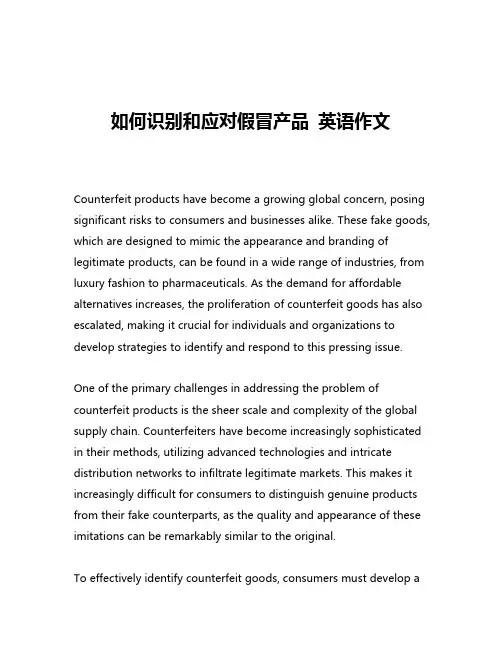
如何识别和应对假冒产品英语作文Counterfeit products have become a growing global concern, posing significant risks to consumers and businesses alike. These fake goods, which are designed to mimic the appearance and branding of legitimate products, can be found in a wide range of industries, from luxury fashion to pharmaceuticals. As the demand for affordable alternatives increases, the proliferation of counterfeit goods has also escalated, making it crucial for individuals and organizations to develop strategies to identify and respond to this pressing issue.One of the primary challenges in addressing the problem of counterfeit products is the sheer scale and complexity of the global supply chain. Counterfeiters have become increasingly sophisticated in their methods, utilizing advanced technologies and intricate distribution networks to infiltrate legitimate markets. This makes it increasingly difficult for consumers to distinguish genuine products from their fake counterparts, as the quality and appearance of these imitations can be remarkably similar to the original.To effectively identify counterfeit goods, consumers must develop akeen eye for detail and a deep understanding of the characteristics of authentic products. This often involves carefully examining the packaging, labeling, and even the product itself for any discrepancies or inconsistencies. For example, genuine luxury items may feature intricate stitching, unique serial numbers, or specialized materials that are difficult to replicate. By familiarizing themselves with these distinctive features, consumers can more readily identify potential counterfeits and make informed purchasing decisions.In addition to visual inspection, consumers can also leverage technology to aid in the detection of counterfeit goods. Many brands now offer mobile applications or online tools that allow users to scan product codes or barcodes to verify their authenticity. These digital solutions can provide real-time information on the provenance and legitimacy of a product, helping consumers to avoid falling victim to fraudulent purchases.Another effective strategy for combating counterfeit products is to support reputable and trusted retailers. By purchasing from authorized dealers or directly from the brand's official channels, consumers can significantly reduce the risk of acquiring counterfeit goods. These established vendors often have robust systems in place to ensure the integrity of their supply chain, reducing the likelihood of counterfeit infiltration.When consumers do suspect that they have purchased a counterfeit product, it is essential to take swift and appropriate action. This may involve reporting the incident to the relevant authorities, such as law enforcement or consumer protection agencies, who can investigate the matter and take legal action against the perpetrators. Additionally, consumers can engage directly with the brand or manufacturer to inform them of the suspected counterfeit, as these companies often have dedicated teams and resources to address such issues.Beyond individual consumer efforts, businesses and governments play a crucial role in combating the proliferation of counterfeit goods. Companies can implement robust supply chain management practices, including rigorous vendor vetting and product authentication measures, to mitigate the risk of counterfeit infiltration. Governments, on the other hand, can strengthen legislative frameworks, enhance border controls, and collaborate with international organizations to disrupt the supply and distribution of counterfeit products.The impact of counterfeit goods extends far beyond the immediate financial loss to consumers and businesses. Counterfeit products can pose significant health and safety risks, particularly in the case of pharmaceuticals, automotive parts, or consumer electronics. Substandard or tampered-with goods can lead to serious injuries,illnesses, or even fatalities, underscoring the urgent need to address this global challenge.In conclusion, the identification and response to counterfeit products require a multi-faceted approach involving consumers, businesses, and governments. By developing a keen awareness of the characteristics of genuine products, leveraging technology-enabled authentication tools, and supporting reputable vendors, consumers can play a vital role in combating the proliferation of counterfeit goods. Businesses and governments must also take decisive action to strengthen supply chain security, enhance legal frameworks, and disrupt the distribution networks of counterfeiters. Only through a collaborative and comprehensive effort can we effectively protect consumers, safeguard intellectual property rights, and foster a more secure and trustworthy marketplace.。
证据的重要性英语作文高中
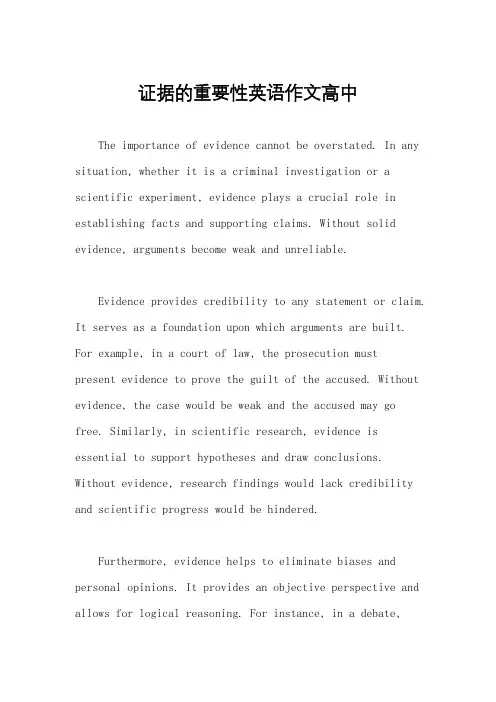
证据的重要性英语作文高中The importance of evidence cannot be overstated. In any situation, whether it is a criminal investigation or a scientific experiment, evidence plays a crucial role in establishing facts and supporting claims. Without solid evidence, arguments become weak and unreliable.Evidence provides credibility to any statement or claim. It serves as a foundation upon which arguments are built. For example, in a court of law, the prosecution mustpresent evidence to prove the guilt of the accused. Without evidence, the case would be weak and the accused may go free. Similarly, in scientific research, evidence is essential to support hypotheses and draw conclusions. Without evidence, research findings would lack credibility and scientific progress would be hindered.Furthermore, evidence helps to eliminate biases and personal opinions. It provides an objective perspective and allows for logical reasoning. For instance, in a debate,presenting evidence can help to counter subjective opinions and bring the discussion back to facts. Evidence allows for a more rational and fair evaluation of arguments, leading to better decision-making.In addition, evidence encourages critical thinking and analysis. It requires individuals to examine information, evaluate its reliability, and draw conclusions based on logical reasoning. This process of analyzing evidence helps to develop analytical skills and promotes a deeper understanding of a subject. It also encourages individuals to question assumptions and seek out alternative explanations.Moreover, evidence serves as a basis for accountability and transparency. In many fields, such as journalism and academia, evidence is essential to ensure the accuracy and integrity of information. Without evidence, claims can be easily manipulated or misrepresented. The presence of evidence holds individuals and institutions accountable for their actions and claims.In conclusion, evidence is of utmost importance in various aspects of life. It provides credibility, eliminates biases, encourages critical thinking, and promotes accountability. Without evidence, arguments lack substance and reliability. Therefore, it is crucial to value and rely on evidence in order to make informed decisions and establish the truth.。
调查这个案件的英语作文
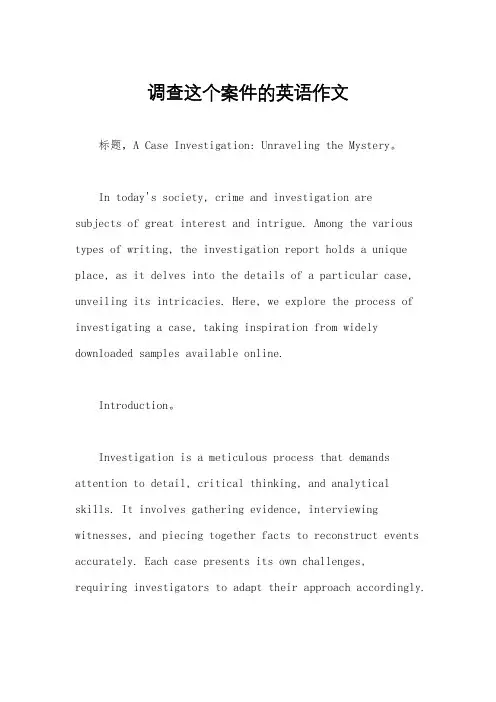
调查这个案件的英语作文标题,A Case Investigation: Unraveling the Mystery。
In today's society, crime and investigation aresubjects of great interest and intrigue. Among the various types of writing, the investigation report holds a unique place, as it delves into the details of a particular case, unveiling its intricacies. Here, we explore the process of investigating a case, taking inspiration from widely downloaded samples available online.Introduction。
Investigation is a meticulous process that demands attention to detail, critical thinking, and analytical skills. It involves gathering evidence, interviewing witnesses, and piecing together facts to reconstruct events accurately. Each case presents its own challenges,requiring investigators to adapt their approach accordingly.Initial Assessment。
The first step in any investigation is to assess the initial information available. This includes understanding the nature of the case, identifying potential leads, and determining the resources required. In our hypothetical scenario, let's consider a case of a missing person. The initial assessment would involve gathering information about the missing individual, their last known whereabouts, and any relevant circumstances surrounding their disappearance.Gathering Evidence。
分辨是真是假英语作文
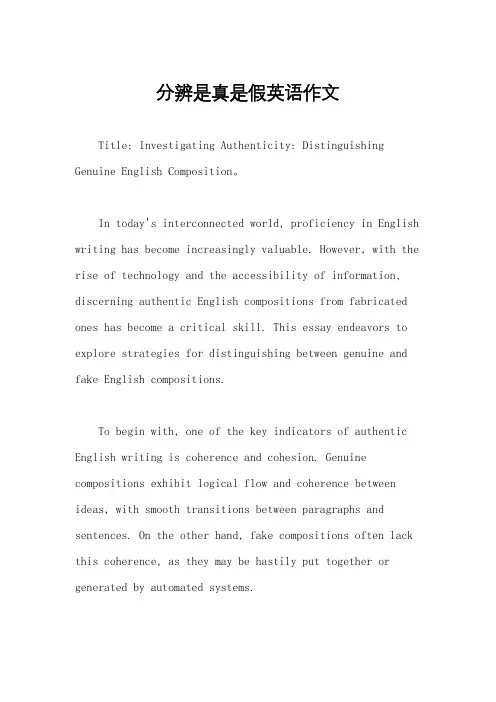
分辨是真是假英语作文Title: Investigating Authenticity: Distinguishing Genuine English Composition。
In today's interconnected world, proficiency in English writing has become increasingly valuable. However, with the rise of technology and the accessibility of information, discerning authentic English compositions from fabricated ones has become a critical skill. This essay endeavors to explore strategies for distinguishing between genuine and fake English compositions.To begin with, one of the key indicators of authentic English writing is coherence and cohesion. Genuine compositions exhibit logical flow and coherence between ideas, with smooth transitions between paragraphs and sentences. On the other hand, fake compositions often lack this coherence, as they may be hastily put together or generated by automated systems.Furthermore, authentic English writing demonstrates a mastery of grammar, vocabulary, and syntax. Genuine compositions showcase a varied vocabulary, appropriate word choice, and grammatical accuracy. Conversely, fake compositions may contain errors in grammar, awkward phrasing, or the misuse of words, which can be indicative of machine-generated content or non-native speakers attempting to mimic English fluency.Another aspect to consider is the authenticity of sources and references. Genuine English compositions often incorporate credible sources to support arguments or provide evidence. These sources are properly cited according to academic conventions or acknowledged in a manner consistent with the genre of writing. In contrast, fake compositions may lack verifiable sources or rely on dubious references, indicating a lack of credibility or originality.Moreover, the depth of analysis and insight is a distinguishing factor in authentic English writing. Genuine compositions demonstrate critical thinking skills,analytical depth, and originality of thought. They offer unique perspectives, thoughtful interpretations, and engage with complex ideas in a meaningful way. Conversely, fake compositions may lack depth, offering superficial analysis or regurgitating commonly held opinions without providing any novel insights.Additionally, the tone and style of writing can reveal clues about the authenticity of a composition. Authentic English writing often reflects the author's voice, personality, and cultural background. It may exhibit nuances of expression, humor, or rhetorical devices that are characteristic of the writer's style. In contrast, fake compositions may sound generic, robotic, or overly formal, lacking the human touch and individuality that typifies genuine writing.Furthermore, examining the context and purpose of the composition can provide insights into its authenticity. Genuine English compositions are typically written for specific audiences, purposes, and genres, with careful consideration given to context and audience expectations.They adhere to conventions of genre, format, and style appropriate to the intended purpose. Conversely, fake compositions may lack this contextual relevance, appearing disconnected or out of place within their intended context.In conclusion, distinguishing between genuine and fake English compositions requires careful attention to various linguistic, stylistic, and contextual cues. By assessing coherence, language proficiency, sources, analysis, tone, style, and context, readers can effectively discern the authenticity of English writing. Developing these critical evaluation skills is essential in navigating the vast landscape of written content in today's digital age.。
嫌疑与证据英语作文
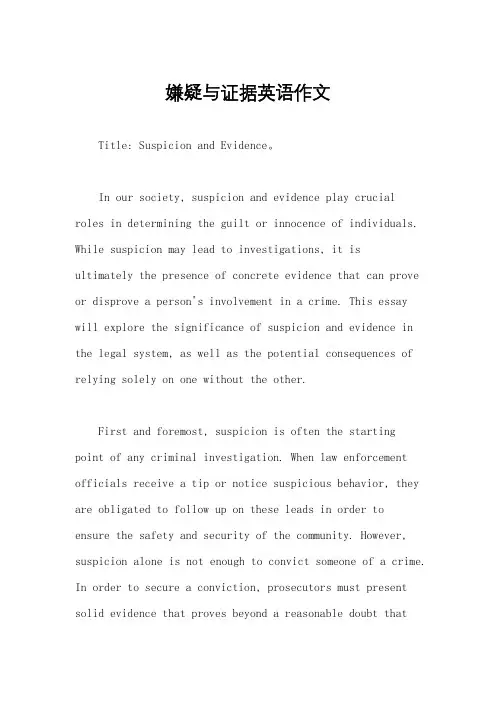
嫌疑与证据英语作文Title: Suspicion and Evidence。
In our society, suspicion and evidence play crucialroles in determining the guilt or innocence of individuals. While suspicion may lead to investigations, it isultimately the presence of concrete evidence that can prove or disprove a person's involvement in a crime. This essay will explore the significance of suspicion and evidence in the legal system, as well as the potential consequences of relying solely on one without the other.First and foremost, suspicion is often the startingpoint of any criminal investigation. When law enforcement officials receive a tip or notice suspicious behavior, they are obligated to follow up on these leads in order toensure the safety and security of the community. However, suspicion alone is not enough to convict someone of a crime. In order to secure a conviction, prosecutors must present solid evidence that proves beyond a reasonable doubt thatthe accused is guilty.On the other hand, evidence is the backbone of any criminal case. Without it, prosecutors would have adifficult time proving their case in court. Evidence can take many forms, including physical evidence such as DNA or fingerprints, eyewitness testimony, and digital evidence such as surveillance footage or electronic communications. It is the presence of this evidence that can either exonerate or incriminate a suspect, and ultimately determine their fate in the legal system.In some cases, suspicion and evidence may not align, leading to potential miscarriages of justice. For example, a person may be wrongly accused of a crime based on circumstantial evidence or bias, despite having a strong alibi or lack of motive. Conversely, a guilty individual may go free if there is not enough evidence to secure a conviction, even if there is a strong suspicion of their involvement in the crime. In these instances, it is essential for the legal system to strike a balance between suspicion and evidence in order to ensure a fair and justoutcome for all parties involved.In conclusion, suspicion and evidence are both important components of the legal system, each playing a unique role in the pursuit of justice. While suspicion may prompt investigations and raise red flags, it is ultimately the presence of concrete evidence that can prove or disprove a person's guilt. By carefully weighing both suspicion and evidence in criminal cases, we can work towards a legal system that is fair, transparent, and just for all.。
辨别信息真伪高中作文英语
辨别信息真伪高中作文英语英文:As a high school student, it is important to be able to discern between true and false information. With the rise of social media and the internet, it has becomeincreasingly difficult to distinguish between what is real and what is fake. This skill is not only important for academic purposes, but also for everyday life.One way to determine the authenticity of information is to consider the source. Is the information coming from a reputable and trustworthy source? For example, if I see a news article shared on social media, I will check to see if it is from a well-known and credible news outlet, such as BBC or The New York Times. If the source is unfamiliar or questionable, I will be more cautious about believing the information.Another important factor to consider is the evidenceand supporting details provided. For instance, if I come across a scientific claim, I will look for data, research studies, or expert opinions that back up the information. Without solid evidence, the information may not be reliable.Furthermore, I will also pay attention to any potential bias or agenda behind the information. Is the author trying to persuade me to believe a certain viewpoint? Are they leaving out important details that may change the interpretation of the information? By asking these questions, I can better evaluate the credibility of the information.In addition, I will take the time to fact-check the information using reliable sources. There are many fact-checking websites and organizations that can help verifythe accuracy of information. By cross-referencinginformation from multiple sources, I can gain a more comprehensive understanding of the topic and avoid falling for misinformation.Overall, being able to discern between true and falseinformation is a crucial skill in today's digital age. By considering the source, evidence, bias, and fact-checking information, I can better navigate the vast amount of information available to me.中文:作为一名高中生,能够辨别真假信息是非常重要的。
证据的重要性英语作文初中
证据的重要性英语作文初中In the realm of academic writing, evidence plays a pivotal role in establishing the credibility and persuasiveness of an argument. For middle school students embarking on the journey of English composition, understanding the significance of evidence is essential to crafting compelling and well-substantiated essays.The Foundation of CredibilityEvidence serves as the backbone of any well-written essay. It provides the necessary support for the claims and arguments presented by the writer. Without it, the essay may come across as a mere collection of unsupported assertions, which can diminish its impact on the reader.Types of EvidenceThere are various forms of evidence that can be incorporated into an essay:1. Factual Evidence: This includes statistics, historical data, and scientific findings that can be used to back up a claim.2. Anecdotal Evidence: Personal stories or experiences can add a human element to an argument, making it more relatable.3. Expert Testimony: Quotes or references from authorities in the field can add weight to the argument.4. Examples: Concrete examples can illustrate a point more clearly than abstract explanations.5. Visual Aids: Graphs, charts, and images can be powerful forms of evidence, especially when dealing with complex data.Integrating EvidenceIntegrating evidence into an essay requires a thoughtful approach:1. Relevance: Ensure that the evidence is directly related to the point being made.2. Sufficiency: Provide enough evidence to fully support the argument without overwhelming the reader.3. Variety: Use a mix of different types of evidence to create a well-rounded argument.4. Citation: Always cite the sources of the evidence to avoid plagiarism and to give credit to the original authors.Evaluating the EvidenceBefore using evidence, it's crucial to evaluate its reliability:1. Source Credibility: Check the reputation and expertise of the source.2. Currency: Ensure that the information is up-to-date and relevant to the current context.3. Bias: Be aware of any potential biases that may affect the objectivity of the evidence.ConclusionIn conclusion, evidence is the cornerstone of a persuasive and informative English composition. Middle school students must learn to recognize its importance, understand the different types, and master the skills of integrating and evaluating evidence in their writing. By doing so, they will not only enhance their academic writing but also develop critical thinking skills that are invaluable in all areas of life.。
慎思明辨识真假的英语作文
In the modern world,where information is abundant and easily accessible,the ability to discern truth from falsehood is a crucial skill.This essay will explore the importance of careful thought and discernment in identifying the authenticity of information.Firstly,the prevalence of misinformation can have serious consequences.Inaccurate news can lead to public panic,misguided decisionmaking,and even social unrest.For instance, healthrelated misinformation can result in people taking harmful actions or neglecting necessary treatments.Secondly,the process of discerning truth requires a multifaceted approach.One must critically evaluate the source of information.Reliable sources typically have a reputation for accuracy and transparency.Additionally,crossreferencing information with other credible sources can help verify its authenticity.Thirdly,an understanding of logical fallacies and cognitive biases is essential.Logical fallacies are errors in reasoning that can lead to incorrect conclusions.Cognitive biases, on the other hand,are systematic errors in thinking that affect the judgments and decisions people make.Being aware of these can help individuals avoid being misled by persuasive but flawed arguments.Moreover,education plays a vital role in fostering discernment.Teaching critical thinking skills from an early age can empower individuals to question and analyze information effectively.This includes learning how to differentiate between facts, opinions,and propaganda.Furthermore,the role of technology cannot be overlooked.While it has contributed to the spread of misinformation,it also offers tools to combat it.Factchecking websites,for example,use algorithms to verify the accuracy of claims made in news articles and social media posts.Lastly,fostering a culture of skepticism and openmindedness is important.Skepticism encourages questioning and doubt,which can prevent the acceptance of false information at face value.Openmindedness,however,ensures that one remains receptive to new information and willing to revise beliefs based on evidence.In conclusion,the ability to discern truth from falsehood is indispensable in todays informationsaturated society.By employing critical thinking,understanding logical fallacies and cognitive biases,leveraging educational resources,utilizing technology,andpromoting a culture of skepticism and openmindedness,individuals can better navigate the complex landscape of information and make informed decisions.。
在财务报告的责任:检测欺诈性公司外文文献翻译
文献信息:文献标题:Accountability in financial reporting:detecting fraudulent firms(在财务报告的责任:检测欺诈性公司)国外作者:Hawariah Dalnial,Amrizah Kamaluddin,Zuraidah Mohd Sanusi,Khairun Syafiza Khairuddin文献出处:Procedia - Social and Behavioral Sciences, 2014, 145:61-69字数统计:英文2507单词,14114字符;中文4242汉字外文文献:Accountability in financial reporting:detecting fraudulentfirmsAbstract This paper aims to investigate whether there are any significant differences between the means of financial ratios of fraudulent and non-fraudulent firms and to identify which financial ratio is significant to detect fraudulent reporting. The sample comprises of 65 fraudulent firms and 65 samples of non-fraudulent firms of Malaysian Public Listed Firms, available between the year of 2000 and 2011. The study found that there are significant mean differences between the fraud and non-fraud firms in ratios such as total debt to total equity, account receivables to sales. In addition, Z score which measures the bankruptcy probability is significant to detect fraudulent financial reporting.Keywords:Financial Ratio; Financial Statement Analysis; Fraudulent Financial Reporting; Public Listed Companies; Malaysia1.IntroductionFraud firms are identified through offences made against the listings requirement of Bursa Malaysia. Fraud is a broad concept with two basic types of fraud seen inpractice. The first is the misappropriation of assets and the second is fraudulent financial reporting (FFR). FFR usually occurs in the form of falsification of financial statements in order to obtain some forms of benefit. Others believe that fraud involves an intentional distortion of financial statements (Ata and Syerek, 2009).Fraud detection is among the highest priorities for capital market participants and other stakeholders in the financial reporting process (e.g., Elliott, 2002; PCAOB, 2007). Market participants such as investors experienced significant financial losses when fraud occurs in publicly-traded companies such as Enron and WorldCom. Some experts suggest that the rate of fraudulent financial reporting will likely increase during the current economic recession and further reiterate the importance of continuous research into ways to flush out fraud (Mintz, 2009).Fraud detection is one of the specific tasks assigned to auditors as stated in ISA 240. Auditors commonly use tools known as analytical procedures to assist them in detecting fraud (Albrecht, Albrecht and Zimbelman, 2009). Analytical procedures refer to the analysis of significant ratios and trends as well as the resulting investigation of fluctuations and relationships that are inconsistent with other relevant information or which deviate from predicted values. Many researchers and fraud investigators recommend financial ratios as an effective tool to detect fraud (Subramanyam and Wild, 2009; Bai, Yen and Yang, 2008; Spathis, 2002; Persons, 1995).The objectives of this paper are firstly, to investigate the significant differences between the mean of financial ratios of fraud and non fraud companies. Secondly, this paper investigates which financial ratios are significant to fraudulent reporting.2.Literature ReviewFinancial distress is an important criteria to monitor when assessing the likelihood of fraudulent financial reporting. When a firm is doing poorly, there is a greater motivation to engage in FFR. Hamer (1983) suggests that most models predict bankruptcy with similar accuracy which implies that poor financial conditions may motivate unethical insiders to improve the appearance of the firms financial positionor perhaps to reduce the threats of loss of employment or to garner as many resources as possible.Overstating assets and revenue is a result of recording revenue prematurely or by using ficticious records. Another study classified the act of manipulating profits into broad categories which include changing accounting methods, fiddling with management estimated cost (Worthy, 1984). Reports by Spathis (2002) suggest that summing up net profit and working capital is a significant predictor of fraud. The reason is, when firms experience a lower net profit versus sales ratio, this indicates that the firm is facing a low return on assets and may attempt to manipulate the financial statement by either increasing revenue or reducing expenditure. Working capital to total assets which reflect in lower liquidity is an incentive for managers to commit fraud and eventually to manipulate the accounting records, thus firms affected by fraud tend to have low liquidity. In addition, Leksrisakul and Evans (2005), stated that firm with consistent operating losses will have shrinking current assets in relation to total assets as evidenced by studies on Thai listed companies.Regardless of the public and policy makers’concern over the management of fraudulent practices, to the best knowledge, there is little empirical research that assesses the probability of fraudulent financial reporting using published data. Few models introduced or employed internationally or locally, provide a list of indicators only meant for insiders especially the auditors and include subjective judgment as developed by Loebbecke, Einning and Willingham (1989). The authors developed a management-fraud assessment model that lists indicators related to fraud. The model involves a great deal of subjective judgment and non-public information, which is available only to the auditors, or insiders of a firm. Investors and policy makers cannot use this model to identify firms engaging in fraudulent financial reporting.Premise on the review of significant articles from previous studies, it is evident that there is still a large gap and an open question on the subject matter. A question of public interest remains as to whether the published data are readily and publicly available and can be used to identify firms engaging in fraudulent financial reporting. Following the research done by Persons (1995) and Spathis (2002), this paper followsthe same approach to detect fraudulent financial statement by using published financial data to detect manipulation of financial statement.3.Hypotheses DevelopmentFor this study, two hypotheses were developed for further testing as well as to support the research objectives. There are a few studies that identify the factors associated with fraudulent financial reporting. Persons (1995) found that financial leverage, calculated as total liabilities to total assets, is the most significant factor associated with fraudulent financial reporting. This suggests that the financial statements of fraudulent firms differ from non fraudulent firms in certain aspects such as higher financial leverage which is denoted by a high means ratio of 0.6096 for fraudulent firms and 0.4868 for non-fraudulent firms , lower capital turnover denoted by the value of 0.2486 for fraudulent firms and 0.3050 for non-fraudulent firms , and assets in fraudulent firms which consist of a higher proportion of current assets particularly inventory and account receivables. Based on the relevant studies, this study investigates the significant differences between financial ratios of fraudulent and non fraudulent public listed firms in Malaysia. With this notion, the hypothesis is as follows:H1: There is a significant difference between the means of the financial ratios between fraudulent and non- fraudulent firms.Financial statement analysis is the application of tools and techniques to financial statements and related data (Subramanyam and Wild, 2009). This is to drive estimates and inferences useful in making decisions. From the financial statement analysis, it reduces the reliance on intuition, presumption and perception that may lead to uncertainty. However, this does not reduce the need of expert judgment; rather it provides a systematic basis for analysis. Ratio analysis is among the most popular and widely used tool for financial statement analysis (Subramanyam and Wild, 2009;Spathis,2002;Persons,1995). Evidence suggests that accounting data are useful when differentiating between fraudulent firms and non fraudulent firms. Accounting data is useful to assist investors in making investment decisions as well as to enablethe auditor to assess the likelihood of fraudulent financial reporting as part of auditor’s duty is to plan the investigation and search for errors or any irregularities that would have material effects on the financial statements (Persons, 1995). This suggests that there is an association between financial statement analyses and fraudulent financial reporting as reported by Bai et al., (2008). Analysing financial information can be used to identify fraudulent and non fraudulent firms via the financial data. Based on those foundations, a second hypothesis was developed:H2: Financial Ratios are significant predictors to fraudulent financial reporting.3.1.Research designThis study examined 130 samples consisting of 65 samples for fraudulent firms and 65 samples of non fraudulent firms from the Malaysian Public Listed Firms available between the year of 2000 and 2011 with financial data collected from Data Stream. Firms involving in fraudulent reporting are obtained from the Bursa Malaysia media centre. This study utilizes the secondary data obtained from published audited financial statements as the main source of information from the corporate annual reports of the public listed firms in Malaysia and also from Data Stream.3.2.Independent variables, dependent variables and control variable3.2.1.Independent variablesFor the purpose of this study, seven aspects of a firm’s financial ratios were identified. These variables are financial leverage, profitability, asset composition, liquidity, capital turnover, size and also overall financial condition. The independent variables are comprised of:(a)Financial leverageFinancial Leverage is measured by Total Debt to Total Equity (TD/TE) and also Total Debt to Total Asset (TD/TA). Higher leverage is typically associated with a higher potential for violations of loan agreements and a reduced ability to obtain additional capital through borrowing. As concluded by Christie (1990), leverage is potentially correlated with income enhancing accounting policies. If these policies are not sufficient to avoid violations of debt covenants, managers may be motivated to understate liabilities or assets. Therefore these variables should be in positive figures.This means, the higher the leverage, the higher the potential for violations and the higher the likelihood of fraud.(b)ProfitabilityProfitability is measured by Net Profit to Revenue (NP/REV). Lower profits may provide management with an incentive to overstate revenues or understate expenses. Kreudfelt and Wallace (1986) finds firms with profitability problems have significantly more errors in their financial statements than other firms. Spathis (2002) also reported that a very low value of the ratio indicates that these firms are facing difficulties of low returns in relation to assets and try to manipulate the financial statement either by increasing revenue or by reducing expenditure. Therefore the variables are expected to be negative values. This means, the lower the profit, the higher the tendency to overstate revenue or expenses and thus a higher likelihood to detect fraud.(c)Asset compositionAsset Composition is measured by Current Assets to Total Assets (CA/TA), Receivables to Revenue (REC/REV) and Inventory to Total Assets (INV/TA). Account receivables as claimed by Feroz, Park and Wetzel (1991) are more likely to be manipulated due to the subjective nature of judgment involved.The reported value ultimately relies on estimating uncollected accounts and obsolete inventory. Due to the subjective nature of the accounts, managers may use these accounts as tools for financial statement manipulation (Summers and Sweeney 1998). Investigations of fraudulent firms involved in FFR indicate that the current assets of these firms consist mostly of receivables and inventory. These findings are consistent with Feroz et al., (1991) who discovered that overstatements of receivables and inventory represent about three – fourths of all SEC enforcement cases. Pierre and Anderson (1984) also found a high frequency of lawsuits against auditors involving inventory and receivables. Loebbecke et al., (1987), Sorenson, Grove and Selto (1983) and Beasly, Carcello and Hermanson (1999) confirm that account receivables and inventory are important variables when assessing the risk of fraud and that both are common items misstated in accounts. These variables are expected to be positivevalues, which show that the higher the amount of both items, the higher the risk of overstatements in the account, which leads to an increase in the likelihood of fraud.(d)LiquidityLiquidity is measured by Working Capital to Total Assets (WC/TA). Lower liquidity may be an incentive for managers to engage in FFR. This argument is supported by Kreutzfelt and Wallace (1986) who found that firms with liquidity problems have significantly more errors in their financial statements than other firms. In addition, Spathis (2002) reports that firms productively utilizing its assets and resources are able to gene rate profits and this is often seen as an indication of a firm’s performance. In addition, firms with a very low working capital to total assets ratio indicates that they cannot meet their obligations. Thus these ratios are expected to be negative values, concluding that the lower a firm’s liquidity the more likely it is for managers to engage in FFR.(e)Capital turnoverCapital Turnover is measured by Revenue to Total Assets (REV/TA). The turnover represents the sales generating power of the firm’s assets. It also measures management’s ability to deal with competitive situations. Managers of fraudulent firms may be less competitive than that of non fraudulent firms in using the firm’s assets to generate sales. This inability to compete successfully may be an incentive for engaging in fraudulent financial reporting. These variables therefore should be negative figures. In other words, firms having difficulty in generating sales are more likely to engage in FFR.(f)Overall financial positionFinancial distress may be a motivation for FFR (Stice,1991). A lower Z-score reflects a higher degree of financial distress, which may be a motive for management fraud (Persons, 1995). Hamer (1993) suggests that most models predict bankruptcy with a similar ability. Poor financial conditions may motivate unethical insiders to take steps intended to improve the appearance of the firm’s financial position. This aspect is measured by the Z-Score. This score measures the rate of bankruptcy of firms. The elements of this Z-Score with their associated weighting are as follows:Z = 1.2 (working capital/total assets) + 1.4 (retained earnings/total assets) + 3.3 (earnings before interest and taxes/ total assets) + 0.06 (market value of equity/book value of total debt) + 1.0 (sales/total assets)Although certain variables mentioned in the Z score are also included in the variables to be tested, an addition of the Z score in the model estimation stage enables us to measure the relative role of the Z score compared to individual variables comprising of the Z score alone. These variables are expected to be negative figures as firms with poorer financial conditions (smaller Z score) are more likely to engage in FFR.3.2.2.Dependant variableThe dependent variable comprises fraud firms and non fraud firms. The lists of fraud firms are obtained from Bursa Malaysia Media Centre. Each fraudulent firm is matched with a corresponding non fraudulent firm on the basis of industry, size and also time period. Firms in the same industry are subject to the similar business environment as well as similar accounting and reporting requirements (Pierre and Anderson, 1984).3.2.3.Control variableSize is measured by the Natural Logarithm of book value of total assets at the end of the fiscal year (SIZE). Feroz et al., (1991) found that most of the firms being closely monitored by the SEC are relatively smaller ones. This variable aims to control total assets to confirm the method of selection.3.3.Regression modelThe following logic model was estimated using the financial ratios from the firms to determine which of the ratios were related to FFR. By including the data set of fraudulent and non fraudulent firms, we may discover what factors significantly influence them:where:SIZE = SizeTD/TE = Total debt/Total equityTD/TA = Total debt/Total AssetNP/REV= Net Profit/RevenueCA/TA = Current Assets/Total Asset REC/REV= Receivable/RevenueINV/TA = Inventories/Total Assets WC/TA = Working Capital/Total Assets REV/TA= Revenue/Total AssetsZ = Z- score中文译文:在财务报告的责任:检测欺诈性公司摘要本文旨在探讨公司欺诈行为与非欺诈行为的财务比率间存在的差别,并确定哪些财务比率是显著的虚假报告。
